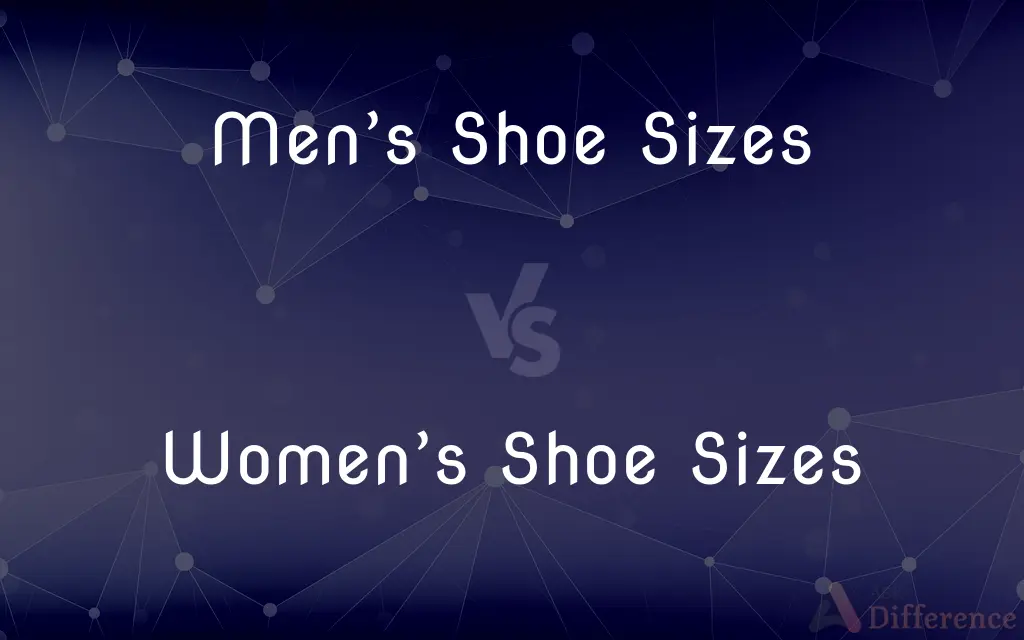Men’s Shoe Sizes vs. Women’s Shoe Sizes — What's the Difference?
Edited by Tayyaba Rehman — By Fiza Rafique — Published on November 3, 2023
Men’s Shoe Sizes are typically wider and larger than Women’s Shoe Sizes, with a size difference often of 1.5-2 sizes.

Difference Between Men’s Shoe Sizes and Women’s Shoe Sizes
Table of Contents
ADVERTISEMENT
Key Differences
Men’s Shoe Sizes are crafted to accommodate the general shape and size of male feet. They are often broader in design and tend to run larger when compared directly to Women’s Shoe Sizes. On the other hand, Women’s Shoe Sizes are designed keeping in mind the average female foot, which is generally narrower and smaller.
A Men’s Shoe Size, for instance, may not only differ in length but also in width when compared to a Women’s Shoe Size. When converting between Men’s Shoe Sizes and Women’s Shoe Sizes, one often adds or subtracts 1.5 to 2 sizes for a comparable fit.
For instance, a size 8 in Men’s Shoe Sizes might be equivalent to a size 9.5 or 10 in Women’s Shoe Sizes. While both Men’s Shoe Sizes and Women’s Shoe Sizes serve to give a comfortable fit, their differentiation ensures that individuals can find shoes tailored to their anatomical needs.
Comparison Chart
Typical Width
Broader
Narrower
Direct Size Comparison
Tends to be larger
Tends to be smaller
ADVERTISEMENT
Conversion Difference
Minus 1.5 to 2 sizes to get women’s size
Plus 1.5 to 2 sizes to get men’s size
Design Focus
Crafted for male foot anatomy
Crafted for female foot anatomy
Common Sizing System
Often starts from a smaller size number
Starts from a larger size number than men's
Compare with Definitions
Men’s Shoe Sizes
Men’s Shoe Sizes help ensure a comfortable and snug fit for male feet.
Brands may offer variations within Men’s Shoe Sizes to cater to different foot shapes.
Women’s Shoe Sizes
Women’s Shoe Sizes, when directly compared, are often smaller than male sizes.
A size 8 in Women’s Shoe Sizes might equate to a size 6.5 in men's in the U.S.
Men’s Shoe Sizes
Men’s Shoe Sizes cater to the general foot anatomy of males.
Broader widths are common in Men’s Shoe Sizes.
Women’s Shoe Sizes
Women’s Shoe Sizes denote the size system for female footwear.
Women’s Shoe Sizes often start from a larger size number than men's in the U.S.
Men’s Shoe Sizes
Men’s Shoe Sizes can vary across countries and shoe brands.
European Men’s Shoe Sizes are different from American Men’s Shoe Sizes.
Women’s Shoe Sizes
Women’s Shoe Sizes may differ based on region or brand.
European Women’s Shoe Sizes have a different numbering system than American Women’s Shoe Sizes.
Men’s Shoe Sizes
Men’s Shoe Sizes refer to the numerical or alphabetical representation of male footwear fit.
Men’s Shoe Sizes typically start from a smaller size number in the U.S.
Women’s Shoe Sizes
Women’s Shoe Sizes are tailored for the typical female foot anatomy.
Narrower designs are prevalent in Women’s Shoe Sizes.
Men’s Shoe Sizes
Men’s Shoe Sizes are often larger when directly compared to female counterparts.
A size 10 in Men’s Shoe Sizes might be a 11.5 or 12 in women's in the U.S.
Women’s Shoe Sizes
Women’s Shoe Sizes aim to provide an optimal fit for female feet.
Many brands have specific designs within Women’s Shoe Sizes for different foot shapes.
Common Curiosities
How do Women’s Shoe Sizes differ from Men’s?
Women’s Shoe Sizes are generally narrower and have a different size scale compared to Men’s Shoe Sizes.
Can men wear shoes with Women’s Shoe Sizes?
With a conversion, which often involves adding 1.5 to 2 sizes, men can find a comparable Women’s Shoe Size.
Are Men’s Shoe Sizes always larger than Women’s Shoe Sizes?
Typically, yes, but it’s crucial to check brand-specific size charts for accuracy.
What are Men’s Shoe Sizes?
Men’s Shoe Sizes are numerical or alphabetical representations used for male footwear sizing.
Do all brands follow the same Men’s Shoe Sizes?
No, sizing can vary slightly among brands.
Why are there different Women’s Shoe Sizes internationally?
Different countries have different sizing systems and measurement methods.
How do I convert between Men’s Shoe Sizes and Women’s Shoe Sizes?
Typically, you'd add 1.5 to 2 sizes to convert from men's to women's and subtract the same to convert the other way.
Why are Men’s Shoe Sizes typically broader?
They are designed to cater to the average male foot, which is usually broader than the female foot.
Can a woman wear shoes from Men’s Shoe Sizes?
Yes, by converting, usually subtracting 1.5 to 2 sizes from the men’s size to get the equivalent women’s size.
Can I use Women’s Shoe Sizes for unisex shoes?
Unisex shoes often have separate Men’s and Women’s Shoe Sizes listed to ensure accurate fitting.
How have Men’s Shoe Sizes evolved over time?
Men’s Shoe Sizes have adapted over time due to changes in foot anatomy and fashion trends.
Why might someone choose shoes from the opposite gender's sizing?
Personal comfort, style preference, or specific fit needs might lead someone to choose shoes from either Men’s or Women’s Shoe Sizes.
Do Men’s Shoe Sizes have more width options than Women’s Shoe Sizes?
Both Men’s and Women’s Shoe Sizes can offer various widths, but availability depends on the brand.
Are Women’s Shoe Sizes standardized globally?
No, there are variations in Women’s Shoe Sizes across different countries.
Do Women’s Shoe Sizes cater to all foot shapes?
While Women’s Shoe Sizes are designed for average female foot anatomy, brands might offer styles to accommodate various foot shapes.
Share Your Discovery

Previous Comparison
Squid vs. SquidGuard
Next Comparison
Oxalate vs. Oxalic AcidAuthor Spotlight
Written by
Fiza RafiqueFiza Rafique is a skilled content writer at AskDifference.com, where she meticulously refines and enhances written pieces. Drawing from her vast editorial expertise, Fiza ensures clarity, accuracy, and precision in every article. Passionate about language, she continually seeks to elevate the quality of content for readers worldwide.
Edited by
Tayyaba RehmanTayyaba Rehman is a distinguished writer, currently serving as a primary contributor to askdifference.com. As a researcher in semantics and etymology, Tayyaba's passion for the complexity of languages and their distinctions has found a perfect home on the platform. Tayyaba delves into the intricacies of language, distinguishing between commonly confused words and phrases, thereby providing clarity for readers worldwide.












































